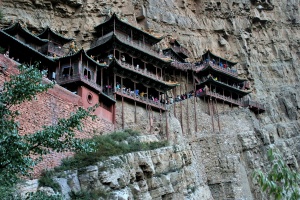 The Xuankong Temple
The Xuankong Temple
The Xuankong Temple Scenic Area is not only a national AAAA-level tourist attraction but also a key cultural relics protection unit across the country. The temple, originally named "Xuankongge," later adopted the moniker "Xuankong Temple" due to its precarious perch on a cliff and the homophonic nature of "xuan" (悬) and "Xuan" (玄). Founded in the late Northern Wei Dynasty (491 AD), the Hanging Temple boasts a history spanning over 1,500 years and stands as a unique temple that integrates Buddhism, Taoism, and Confucianism. Its architecture is highly distinctive, renowned for its precipitous position that seems to hang over an abyss. The temple complex follows a layout resembling "one courtyard with two pavilions," stretching approximately 32 meters in length and encompassing 40 pavilions and halls.
The architectural structure of the Xuankong Temple is also unique, featuring single eaves, double eaves, and triple eaves on its roofs. The structural components include raised beam structures and flat roof structures. The overall appearance is constructed and layered, creating a sense of caves within buildings and buildings within caves. In terms of mechanical principles, the Xuankong Temple is supported by semi-inserted crossbeams, which rely on the support of the rock. The verandas, railings, upper and lower beams, and columns are closely connected to form a wooden frame structure. This design not only enhances the earthquake resistance but also demonstrates the wisdom and skills of ancient craftsmen. Furthermore, the Xuankong Temple cleverly utilizes the natural state of the cliffs to arrange and construct various parts of the temple, integrating the layout and forms of traditional temple architecture into a three-dimensional space.
The Xuankong Temple houses statues and deities representing Buddhism, Taoism, and Confucianism, embodying the inclusivity of Chinese culture. Visitors to the Xuankong Temple can admire its unique architectural style and rich historical and cultural heritage. Meanwhile, the Hengshan Mountain scenic area, where the Xuankong Temple is located, boasts beautiful scenery, allowing tourists to enjoy the natural beauty of Hengshan Mountain while exploring the Xuankong Temple.
Travel Information
Opening hours:
Every year from March 1 to October 31 08:00-17:00
Area: 6.55 square kilometers




































